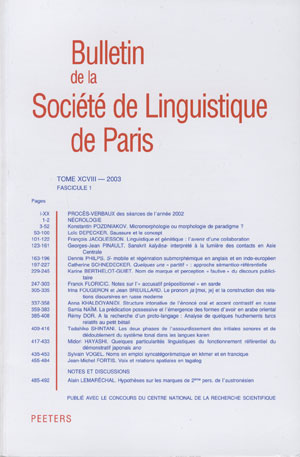 previous article in this issue previous article in this issue | next article in this issue  |

Preview first page |
Document Details : Title: Quelle syntaxe, incidemment, pour les adverbes incidents? Author(s): BONAMI, Olivier , GODARD, Danièle Journal: Bulletin de la Société de Linguistique de Paris Volume: 102 Issue: 1 Date: 2007 Pages: 255-284 DOI: 10.2143/BSL.102.1.2028206 Abstract : Nous nous appuyons sur les données du français pour étudier les propriétés des adverbes en fonction d’ajouts incidents (ou plus simplement, adverbes incidents), et ce qui les oppose à celles des adverbes ordinaires, intégrés; puis nous montrons brièvement comment ils peuvent être pris en compte dans une grammaire. L’incidence est une propriété des occurrences, et non des items lexicaux: il n’y a donc pas de corrélation avec des classes sémantiques ou un fonctionnement pragmatique spécifiques. Les adverbes incidents peuvent être ou non parenthétiques, c’est-à-dire ne pas contribuer ou contribuer au contenu principal de la proposition. Il s’agit d’un statut prosodique (bien que leur réalisation phonétique ne soit pas unique), corrélé à des propriétés syntaxiques et des propriétés de portée. Crucialement, les adverbes incidents ne peuvent pas être considérés comme étant hors du champ de la grammaire, car leur occurrence est syntaxiquement contrainte: ils n’apparaissent pas à l’intérieur d’un constituant majeur de la phrase (sauf à l’intérieur du syntagme verbal), et toutes les positions ne sont pas également ouvertes aux adverbes incidents et intégrés. De plus, l’incidence a un corrélat sémantique, en ce que, contrairement à ce qui se passe pour les adverbes intégrés, leur portée n’est pas contrainte par leur position. Nous adoptons un modèle de grammaire syntagmatique, qui distingue entre une structure tectogrammaticale (pour la constituance et les fonctions) et une structure phénogrammaticale (pour l’ordre des constituants). Dans cette perspective, ils sont analysés comme des ajouts à la phrase, qui sont linéarisés librement au début ou à la fin de la phrase, ou entre les constituants majeurs. Taking our data from French, we study the properties of ‘incidental adverbs’, which set them apart from ordinary, integrated adverbs and briefly show how to integrate them into the grammar. Incidentality is a property of the occurrence of items rather than a property of lexical items proper. There is no correlation with specific semantic classes, or a specific pragmatic behavior. Incidental adverbs can be parenthetical or not, that is, they fail to contribute, or do contribute, to the main content of the proposition. What defines them is their prosodic status, although their phonological realization is not unique. This status is correlated with distributional and scopal properties. Crucially, incidental adverbs cannot be seen as outside grammar, since their occurrence is syntactically constrained: they may not occur inside one of the consituents of the sentence (except for the VP), and it is not the case that incidental and integrated adverbs can occur indifferently in all positions. We adopt a version of phrase structure grammar, where the tectogrammatical structure (for constituency and grammatical functions) is distinguished from the phenogrammatical structure (for word order). In this perspective, they can be analyzed as adjuncts to the sentence, and linearized freely at the beginning, or the end of the sentence, or between the sentential constituents. Im vorliegenden Aufsatz befassen wir uns mit den Eigenschaften der sogenannten ‘eingeschobenen Adverbien’, die sich von gewöhnlichen integrierten Adverbien unterscheiden, und zeigen anschließend, wie eingeschobene Adverbien in einer Grammatik beschrieben werden können. Die Eigenschaft, ein eingeschobenes Adverb zu sein, hat mit der konkreten Verwendung zu tun und nicht mit den lexikalischen Eigenschaften. Dementsprechend besteht keine Korrelation mit bestimmten semantischen Klassen oder mit einer bestimmten pragmatischen Funktionsweise. Eingeschobene Adverbien können parenthetisch sein, müssen es aber nicht: das eingeschobene Adverb trägt also nicht notwendigerweise zum Wahrheitswert des Satzes bei. Ein Merkmal der eingeschobenen Adverbien ist ihr prosodischer Status, auch wenn die phonetische Realisierung der Adverbien nicht einheitlich ist. Der prosodische Status ist mit syntaktischen und skopalen Eigenschaften korreliert. Wir zeigen weiterhin, dass eingeschobene Adverbien nicht als ein Phänomen außerhalb der Grammatik analysiert werden können, da ihre Verteilung durch syntaktische Bedingungen beschränkt wird: sie können nicht innerhalb einer Konstituente eingefügt werden (mit Ausnahme der VP), und darüber hinaus stimmen die Verteilungen von eingeschobenen und integrierten Adverbien nicht überein. Des weiteren unterscheiden sich eingeschobene Adverbien von integrierten Adverbien dadurch, dass ihre Skopuseigenschaften nicht von ihrer Position im Satz bestimmt werden. Wir formulieren unsere Analyse im Rahmen einer Variante der Phrasenstrukturgrammatik HPSG, in der tektogrammatische Informationen (über Konstituentenstruktur und grammatische Funktionen) von phänogrammatischen Informationen (die letztendlich die Wortstellung bestimmen) unterschieden werden. In diesem Rahmen können eingeschobene Adverbien als Adjunkte auf Satzebene analysiert werden, deren Linearisierung freigestellt bleibt und die somit am Satzanfang, am Satzende oder zwischen den Konstituenten linearisiert werden können. |
|


